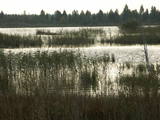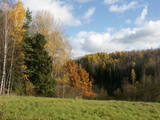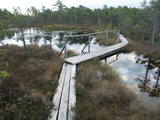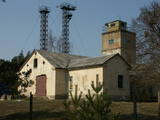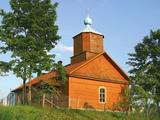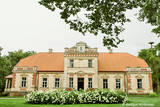| Нo | Название | Описание |
|---|---|---|
|
Peat moss has been extracted from the Seda heath since the middle of the last century, but it is nevertheless one of the most important NATURA 2000 territories in Latvia, with a great diversity of landscapes, biotopes and biology – birds in particular. This is a good place for bird-watching during migration season, and viewing towers have been set up on the edge of the swamp for this purpose.
|
||
|
Prepared blood sausages both traditional and more modern. The farms offer sausage-making demonstrations for various interest groups. Farm sausages are special with the prize won at the Riga Food exhibition - People's Taste. Open at any time by prior arrangement. |
||
|
The Krustkalni Nature Reserve was established in 1977, and the diversity of plants in the region is based both on the terrain – the Madona-Trepe embankment, a series of hillocks with low areas among them, swamps and small lakes – and on the biotope – natural meadows, forest glades, places where underground streams bubble up to the surface, and vast areas of forest with very old stands of trees. Some 800 types of plants have been defined in the reserve. It can be toured only in the company of a guide from reserve headquarters, and one must apply in advance. Visitors can visit the Krāku streams, Lake Svēte-Dreimaņi, and other sites. |
||
|
The Teiči Nature Reserve was established in 1982 and is one of the largest areas of moss swamps in the Baltic region. It consists of the Teiči and the Pelečāre swamps, with a variety of plants and animals, as well as adjacent territories which are under protection. The Teiči swamp is the largest nesting ground for a number of bird species, including the common crane, the whimbrel, the golden plover and the wood sandpiper. During migratory seasons, thousands of geese of various kinds are found in the area. The reserve can be toured only in the company of a guide from reserve headquarters, and one must apply in advance for such a tour. Visitors will see the pathway of footbridges on Lake Silda, as well as Siksala island, which offers a magnificent view of Latvian swampland from a viewing tower. |
||
|
Крестьянское хозяйство «Иесалниеки-1» находится в Плявиньском крае Виеталвской волости. Основная сфера деятельности хозяйства – выращивание зерновых (рапс, ячмень, пшеница и травы). Общая площадь – 180 га. Интересен тот факт, что оба брата ведут хозяйство вместе и общими силами обрабатывают более 800 га. |
||
|
Ресторан «Марияс кафия» находится в центре города Резекне рядом с университетом, в здании со сводчатыми погребами. Латышская кухня: Холодный суп, тонкие и картофельные блины, свиное жаркое, свиные ребрышки, котлеты из телятины, тушеная баранина, жареная треска или форель. Особое блюдо: Салат из козьего сыра. |
||
|
Teritorijas apskates nolūkos ir izveidota un labiekārtota dabas izziņas taka. Dabas liegums atrodas Abavas senlejas dabas parka teritorijā. Taka iepazīstina ar vienīgo krūmu čužas savvaļas augšanas vietu Latvijā. |
||
|
This is one of the most beautiful and popular tourism locations in Vidzeme. The cliff is 45 metres high, and the height of the lovely open-faced portion is around 20 metres high. You can look at the wide and deep Amata River valley and its forested banks.
|
||
|
In the centre of Līgatne, on the right bank on the rapid Līgatne River, there is a viewing plan which offers a close-up look at one of the most impressive sandstone cliffs which rise above it – the Lustūzis cliff. There are artificial caves in the wall of the cliff, which locals use as cellars and as places to store their property.
|
||
|
Во время этого тура вы узнаете о различных путях использования молока – либо для еды, либо для косметических процедур. Из Риги, через исторический и спа курорт Юрмалу, маршрут ведет на козью ферму, где вы попробуете сыры, а также эсклюзивное мороженое из козьего молока. Затем посетите Дундагский замок и попробуйте местные молочные продукты. В Рое познакомьтесь с местными традициями, отведайте рыбацкую еду и поучаствуйте в различных мероприятиях. Затем маршрут идет вдоль нетронутых песчаных пляжей мыса Колка к образцовому городу Вентспилсу, а оттуда поворачивает к живописной Кулдиге с ее хорошо сохранившимся деревянным зодчеством. Затем насладитесь красивым Поместьем Молока, где сможете опробовать разнообразные спа-процедуры на основе молока. Здесь же находится Музей Молока, где вы можете проследить за путем молока от коровы до стола, а также попробовать себя в выполнении различных работ, типа сбивания масла. А далее, маршрут становится сладким. Посетите конфетную фабрику в Салдус, где изготовляют вручную традиционные ириски. Затем в меню мороженое в Друве. Далее – осмотр достопримечательностей в Елгаве, которая когда-то была основным местонахожением герцога Курляндского. Посетите производителя сыров в Элея, а перед отъездом в Ригу посетите великолепный Рундальский дворец, который считается красивейшей жемчужиной Балтики. |
||
|
Хотя в наши дни мыс Колка находится в свободном доступе для местных жителей и посещений туристов, сам пост погранохраны все еще выполняет свои функции и закрыт для гражданских лиц.
|
||
|
В хозяйстве выращиваются молочные коровыя (Геллоувей, Херефорд, Лимузин, Шароле, Латвийская коричневая). Предлагается познавательная экскурсия, во время которой можно понаблюдать за тем, как кормятся телята. |
||
|
Известное еще со времен Курземского герцогства как самое северное место, где выращивали и делали кисловатое вино герцогства. С 1999 г. ежегодно, во второй половине июля, в Сабиле проходит Праздник вина. С Винной горы приоткрывается прекрасный вид на провинциальный город, который расположился на берегах древней долины Абавы. |
||
|
Моленная Липушкской старообрядческой общины постро-
ена в 1893 году. Старообрядческий приход в Липушки в то время
являлся крупнейшим в странах Балтии.
|
||
|
Из Риги маршрут ведет в Сигулду, где вы сможете увидеть Олимипийскую бобслейную трассу, посетить средневековый замок Сигулду и проехать в вагончике по канатной дороге до средневекового замка Турайда, наслаждаясь видом на долину реки Гауя. Детям понравятся развлечения, предлагаемые приключенческим центром Тарзан. В парке Лигатне пройдитесь по природным тропам, для того, чтобы понаблюдать за местными дикими животными на их огороженных территориях, а также погуляйте по исторической деревне, изначально возникшей вокруг бумажной фабрики. А далее направляйтесь в Цесис, чтобы посмотреть на впечатляющие руины средневекового замка, а также на живописное обнажение девонских песчаных пород – утес Зварте в Карли. Затем маршрут идет вдоль морского побережья с его песчаными пляжами, идеальными для прогулок, игр и купания. Здесь посетите музей величайшего в мире лгуна – Мюнгхаузена и послушайте истории его необычайных приключений. Затем маршрут ведет в западную часть Латвии и фокусируется на морской и прибрежной жизни. На выезде из Риги посетите морской курорт Юрмалу, остановитесь в Музее Шоколада в Пуре, а затем направляйтесь на мыс Колка, где Рижский залив встречается с открытым морем. Затем пройдитесь по тропам Национального парка Слитере, посетите деревни ливов – одной из самых малочисленных этнических групп в мире , отведайте свежекопченой рыбы. В Вентспилсе найдете множество развлечений для детей – детский городок, узкоколейную железную дорогу, аквапарки, хорошо оборудованный пляж и парк приключений. На обратном пути в Ригу посетите очаровательную Кулдигу с ее хорошо сохранившимся деревянным зодчеством и остановитесь на ферме, где дети смогут пообщаться с сельскими животными. |
||
|
В исторических источниках усадьба Якишкяй упоминается с конца XVI в. В архитектуре усадьбы преобладают черты классицизма. Из бывших усадебных построек до наших дней дошли лишь главный дворец, ледник и паровая мельница. Усадьба пока не отреставрирована, поэтому отличается полной аутентичностью. Художественный дух здесь оберегают различные предметы, оставшиеся от помещиков Кошколей и с советских времен. Рядом с усадьбой сохранились и некоторые фрагменты усадебного парка, который ранее занимал 2 га: подъездная липовая аллея, ценные старые лиственницы, тополя, сосны, а также небольшой пруд. |
||
|
Находится в 0,1 м к югу от развалин Гробиньского замка, на правом берегу Гробиньского водохранилища. Гробиня является одним из древних заселенных мест Латвии, так как в период с VII по IX вв. (согласно другим источникам IV – Х вв.) здесь находилась крупная известная на территории теперешней Балтии скандинавская колония торговцев и воинов. Переселенцы-колонисты из Готланда и Швеции образовали колонию на холме правого берега судоходной в то время реки Аланде Скабаржкалнсе. Считается, что именно здесь находился упоминаемый в хрониках IX века куршский Юрпилс (Seeburg). Происхождение топонима (Скабаржкалнс) связывают с тем фактом, что в Курземе грабы в свое время назвали гробами. Скабаржкалнс - древнее городище куршей, рядом с которым найдены остатки древнего города. Исторические источники свидетельствуют о том, что в 1263 году замок куршей без боя был отдан рыцарям Ливонского ордена для сожжения. С противоположным берегом городище соединяет небольшая деревянная переправа. |
||
|
Atpūtas centrā tiek piedāvāta iespēja atpūsties brīvā dabā kolektīviem vai individuāliem apmeklētājiem. Iespējams izmēģināt dažādus metamos ieročus (nažus, cirvjus u.c.), kā arī šaušanu ar dažāda veida lokiem, arbaletiem, pneimatiku u.c. |
||
|
This tour is suitable only for experienced hikers. The itinerary circles the Suurupi Peninsula where the dense forests conceal the military heritage of different eras. The Baltic Coastal Hiking Route meanders through overgrown and rocky seacoasts, birch groves, along former pioneer camps and sand-stone cliffs protecting coves with sharp capes. At the end of the itinerary, one of the most astounding outcrops of the Estonian littoral rises before your eyes – the Rannamõisa Cliffs, which gives views of Kakumäe Bay and Peninsula and the towers of Tallinn’s Old Town |
||
|
Der Turm war der Eckturm der mittelalterlichen Stadtmauer von Pärnu. Der Turmhof ist ein beliebter Ort für Kunsthandwerkermärkte und ein Veranstaltungsort. |
||
